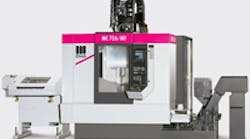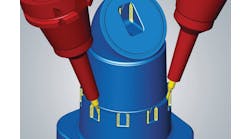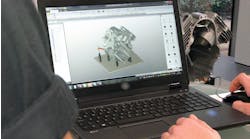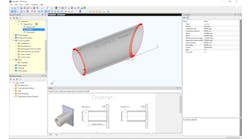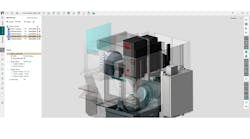System 7 (MT Series) from STAMA, a milling/turning machining center for complete six-sided machining of small and medium batch runs.
In the development of the new System 7 milling/turning center from German machine tool builder, STAMA, there were some distinct challenges for the control supplier. On this innovative machining center, a single five-axis milling spindle is combined with one or two turning spindles and trunnion-mounted workpiece positioning for true six-sided, fully-automated machining for blank bar stock or from a chuck.
Traditionally, when small to medium batches were required, economic inefficiencies involved in using a multi-tasking machining center required that the work would be machined on multiple machines. STAMA sought to produce a highly flexible machine, capable of milling, drilling, thread cutting, external/internal turning, facing and contouring, that could offer more customers the ability to use it on shorter runs. Because short set-up and changeover times were distinct goals of the System 7 design team, the control selection process became all the more complex, according to STAMA director of sales, Gerhard Ulmer.
“And, compounding our challenge,” Ulmer continued, “we had a great demand for high accuracy under production conditions, because our automotive and our medical customers require it. … 0.02-mm true position under 1.67 Cpk conditions are typical for our twin spindle machines. With some of the extreme alloys our customers process, holding that standard would not be so easy to achieve.”
Siemens SINUMERIK 840D, which along with the NCU (Numerical Control Unit) 573.5, forms the CNC that runs STAMA’s System 7 machine.
The inherent advantages of twin-spindle machines have always included a smaller footprint, power savings, increased productivity (42% versus single-spindle designs, according to an Aachen University study) and a reduction in overall cost per part. Correspondingly, the base cost of the machine and the changeover times meant these machines were generally best suited for fewer and longer production runs. While STAMA serves Tier One automotive and other customers who fit this profile exactly, its goal was to design a machine for their Tier Two and Tier Three automotive suppliers, as well as high-precision, short-run customers, according to Ulmer.
From the beginning of the process, the STAMA design team considered their customers’ main concern, namely, how to devise a solution that would allow twin-spindle and single-spindle work to be processed with economy, on the same machine. Clearly, this new machine would require a very high level of motion control, accuracy and multi-function capability. Customers would need the options to machine one piece simultaneously with two spindles; to run separate smaller parts on each spindle independently; or to change tooling on one spindle while the other was machining (zero-based toolchanging).
And, for true six-sided machining, one spindle would need to function as the rotary actuator for the workpiece. To pack all these features into a single machining center and not price it out of competitiveness was a major concern for the STAMA designers.
The control solution they chose was the Siemens SINUMERIK 840D with NCU (Numerical Control Unit) 573.5, a CNC of open architecture, PC-based design that is capable of handling up to 31 axes and 10 channels. Siemens motors, power supplies and drives also were selected for the System 7 as a turnkey package, as was the TRAORI software suite from Siemens. This software is based on transformation orientation that drives the cutting motions relative to the position of the workpiece, not the NC program. With the “look ahead” function, this proprietary Siemens software also speeds the cutting time and overall finishing time on the part, especially critical for STAMA automotive customers and on the complex materials cut by STAMA medical customers.
System 7 from STAMA combines five-axis machining with trunnion-mounted twin spindle technology to allow vertical or horizontal machining, bar stock feed or chucking. Customers have reported a 70% reduction in throughput time and over 30% true cost savings per part produced.
According to Gerhard Ulmer, “We did some modifications of their software for the particular needs of our customers, but the base model and the flexibility of the Siemens CNC package made this supplier the only choice for STAMA on the System 7. It’s the first true control package for a mill/turn machine in the world,” Ulmer observed. He further cited customers reporting a minimum 70% reduction in throughput time savings on the System 7, as compared to their previous machines or methods.
As a result, the programming of single- or twin-spindle use, in all configurations desired by STAMA, was achieved. As Ulmer points out, “It doesn’t matter if the machine is running as a five-axis mill or a lathe. Other CNCs we considered had to switch their operational mode, while the Siemens SINUMERIK 840D can run any program seamlessly.” He also mentioned the control was very robust and safety-conscious, essential for the medical market especially. When cutting cobalt chromium, Nitinol (nickel titanium) and other alloys commonly used in the production of medical implants, surgical tools, and instruments, tool wear is common. Up to 30,000 tool changes per day are not uncommon, according to Ulmer, who cited the rigidity of the System 7 frame and the out-of-tolerance tool detection capability of the CNC as key features for STAMA’s medical customers worldwide.
Ulmer noted that the cooperation of Siemens engineering was vital to the development process on this new milling/turning center. “They (Siemens engineering personnel) were in-house at STAMA from the outset. We had worked with another CNC supplier previously and never received such service. I can say without hesitation that the Siemens CNC was key to the development of the System 7, as well as our System 8, designed for the larger workpieces and chucks. It was a true example of simultaneous engineering on our part and theirs, to devise the best result. Moreover, our customers report a true 30% reduction in part cost with the System 7 already, and that’s really the best result from this entire process.”
